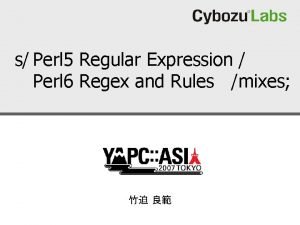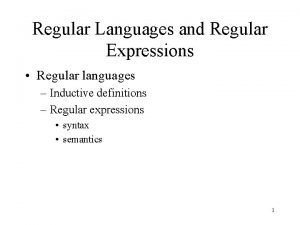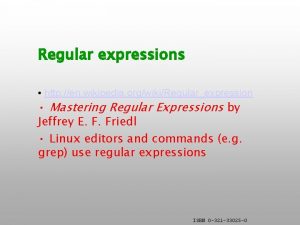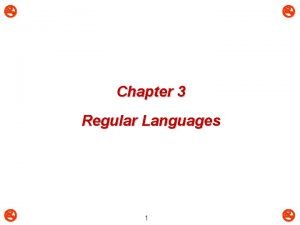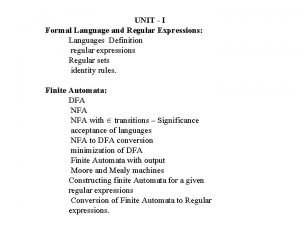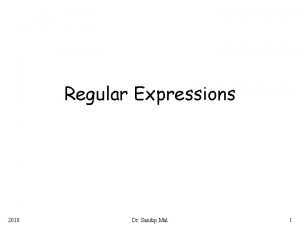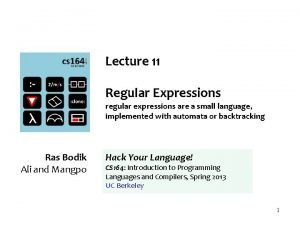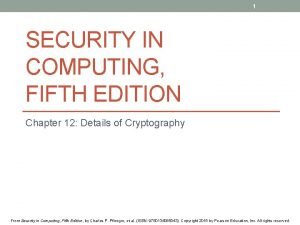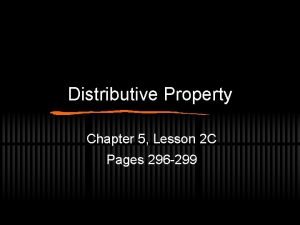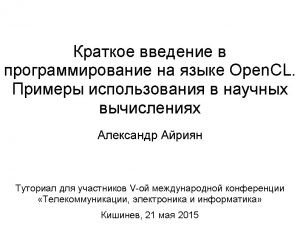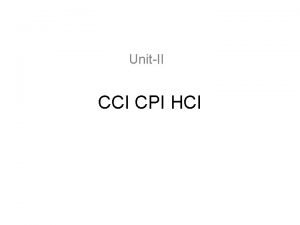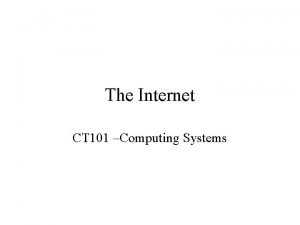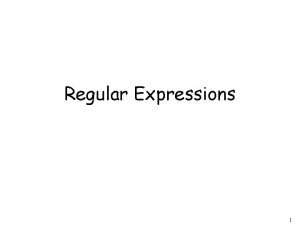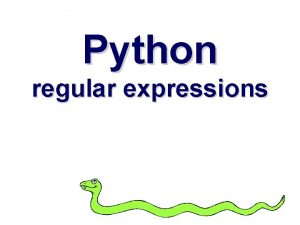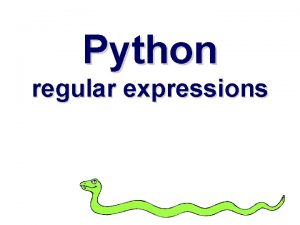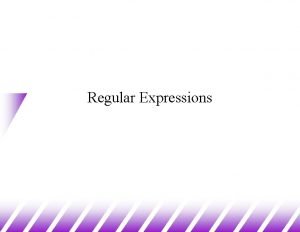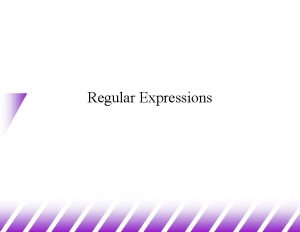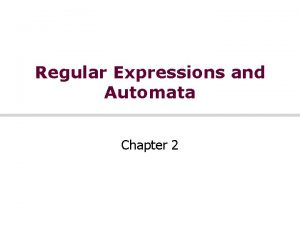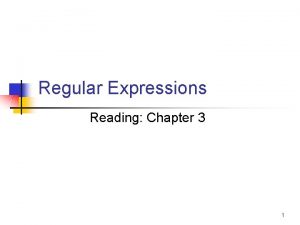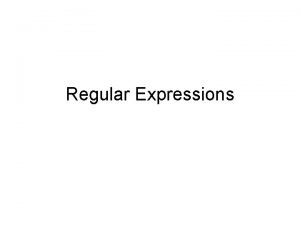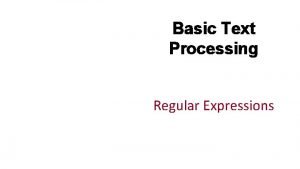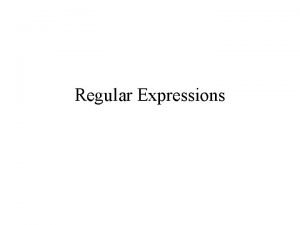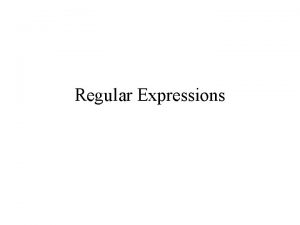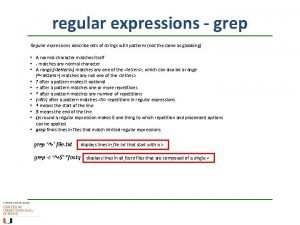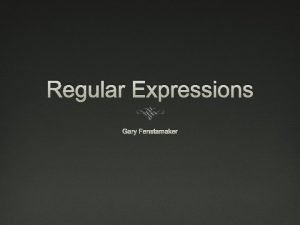Regular Expressions Chapter 11 Regular Expressions In computing






![Regular Expression Quick Guide ^ $. s S * *? + +? [aeiou] [^XYZ] Regular Expression Quick Guide ^ $. s S * *? + +? [aeiou] [^XYZ]](https://slidetodoc.com/presentation_image_h2/a096b97d4773bf1b26d74ec1676f2c80/image-7.jpg)



























- Slides: 34

Regular Expressions Chapter 11

Regular Expressions In computing, a regular expression, also referred to as “regex” or “regexp”, provides a concise and flexible means for matching strings of text, such as particular characters, words, or patterns of characters. A regular expression is written in a formal language that can be interpreted by a regular expression processor. http: //en. wikipedia. org/wiki/Regular_expression

Regular Expressions Really clever “wild card” expressions for matching and parsing strings http: //en. wikipedia. org/wiki/Regular_expression

Really smart “Find” or “Search”

Understanding Regular Expressions • Very powerful and quite cryptic • Fun once you understand them • Regular expressions are a language unto themselves • A language of “marker characters” - programming with characters • It is kind of an “old school” language - compact

http: //xkcd. com/208/
![Regular Expression Quick Guide s S aeiou XYZ Regular Expression Quick Guide ^ $. s S * *? + +? [aeiou] [^XYZ]](https://slidetodoc.com/presentation_image_h2/a096b97d4773bf1b26d74ec1676f2c80/image-7.jpg)
Regular Expression Quick Guide ^ $. s S * *? + +? [aeiou] [^XYZ] [a-z 0 -9] ( ) Matches the beginning of a line Matches the end of the line Matches any character Matches whitespace Matches any non-whitespace character Repeats a character zero or more times (non-greedy) Repeats a character one or more times (non-greedy) Matches a single character in the listed set Matches a single character not in the listed set The set of characters can include a range Indicates where string extraction is to start Indicates where string extraction is to end https: //www. py 4 e. com/lectures 3/Pythonlearn-11 -Regex-Handout. txt

The Regular Expression Module • Before you can use regular expressions in your program, you must import the library using “import re” • You can use re. search() to see if a string matches a regular expression, similar to using the find() method for strings • You can use re. findall() to extract portions of a string that match your regular expression, similar to a combination of find() and slicing: var[5: 10]

Using re. search() Like find() hand = open('mbox-short. txt') for line in hand: line = line. rstrip() if line. find('From: ') >= 0: print(line) import re hand = open('mbox-short. txt') for line in hand: line = line. rstrip() if re. search('From: ', line) : print(line)

Using re. search() Like startswith() import re hand = open('mbox-short. txt') for line in hand: line = line. rstrip() if line. startswith('From: ') : print(line) hand = open('mbox-short. txt') for line in hand: line = line. rstrip() if re. search('^From: ', line) : print(line) We fine-tune what is matched by adding special characters to the string

Wild-Card Characters • The dot character matches any character • If you add the asterisk character, the character is “any number of times” Many Match the start of the times line X-Sieve: CMU Sieve 2. 3 X-DSPAM-Result: Innocent X-DSPAM-Confidence: 0. 8475 X-Content-Type-Message-Body: text/plain ^X. *: Match any character

Fine-Tuning Your Match Depending on how “clean” your data is and the purpose of your application, you may want to narrow your match down a bit Match the start of the line X-Sieve: CMU Sieve 2. 3 X-DSPAM-Result: Innocent X-Plane is behind schedule: two weeks X-: Very short Many times ^X. *: Match any character

Fine-Tuning Your Match Depending on how “clean” your data is and the purpose of your application, you may want to narrow your match down a bit Match the start X-Sieve: CMU Sieve 2. 3 the line X-DSPAM-Result: Innocent X-: Very Short X-Plane is behind schedule: two weeks of One or more times ^X-S+: Match any non-whitespace character

Matching and Extracting Data • re. search() returns a True/False depending on whether the string matches the regular expression • If we actually want the matching strings to be extracted, we use re. findall() [0 -9]+ One or more digits >>> import re >>> x = 'My 2 favorite numbers are 19 and 42' >>> y = re. findall('[0 -9]+', x) >>> print(y) ['2', '19', '42']

Matching and Extracting Data When we use re. findall(), it returns a list of zero or more sub-strings that match the regular expression >>> import re >>> x = 'My 2 favorite numbers are 19 and 42' >>> y = re. findall('[0 -9]+', x) >>> print(y) ['2', '19', '42'] >>> y = re. findall('[AEIOU]+', x) >>> print(y) []

Warning: Greedy Matching The repeat characters (* and +) push outward in both directions (greedy) to match the largest possible string One or more characters >>> import re >>> x = 'From: Using the : character' >>> y = re. findall('^F. +: ', x) >>> print(y) ['From: Using the : '] Why not 'From: ' ? ^F. +: First character in the match is an F Last character in the match is a :

Non-Greedy Matching Not all regular expression repeat codes are greedy! If you add a ? character, the + and * chill out a bit. . . >>> import re >>> x = 'From: Using the : character' >>> y = re. findall('^F. +? : ', x) >>> print(y) ['From: '] One or more characters but not greedy ^F. +? : First character in the match is an F Last character in the match is a :

Fine-Tuning String Extraction You can refine the match for re. findall() and separately determine which portion of the match is to be extracted by using parentheses From stephen. marquard@uct. ac. za Sat Jan >>> y = re. findall('S+@S+', x) >>> print(y) ['stephen. marquard@uct. ac. za’] 5 09: 14: 16 2008 S+@S+ At least one non-whitespace character

Fine-Tuning String Extraction Parentheses are not part of the match - but they tell where to start and stop what string to extract From stephen. marquard@uct. ac. za Sat Jan >>> y = re. findall('S+@S+', x) >>> print(y) ['stephen. marquard@uct. ac. za'] >>> y = re. findall('^From (S+@S+)', x) >>> print(y) ['stephen. marquard@uct. ac. za'] 5 09: 14: 16 2008 ^From (S+@S+)

String Parsing Examples…

21 31 From stephen. marquard@uct. ac. za Sat Jan 5 09: 14: 16 2008 >>> data = 'From stephen. marquard@uct. ac. za Sat Jan 5 09: 14: 16 2008' >>> atpos = data. find('@') >>> print(atpos) 21 Extracting a host >>> sppos = data. find(' ', atpos) >>> print(sppos) name - using find 31 and string slicing >>> host = data[atpos+1 : sppos] >>> print(host) uct. ac. za

The Double Split Pattern Sometimes we split a line one way, and then grab one of the pieces of the line and split that piece again From stephen. marquard@uct. ac. za Sat Jan words = line. split() email = words[1] pieces = email. split('@') print(pieces[1]) 5 09: 14: 16 2008 stephen. marquard@uct. ac. za ['stephen. marquard', 'uct. ac. za'] 'uct. ac. za'

The Regex Version From stephen. marquard@uct. ac. za Sat Jan 5 09: 14: 16 2008 import re lin = 'From stephen. marquard@uct. ac. za Sat Jan y = re. findall('@([^ ]*)', lin) print(y) ['uct. ac. za'] 5 09: 14: 16 2008' '@([^ ]*)' Look through the string until you find an at sign

The Regex Version From stephen. marquard@uct. ac. za Sat Jan 5 09: 14: 16 2008 import re lin = 'From stephen. marquard@uct. ac. za Sat Jan y = re. findall('@([^ ]*)', lin) print(y) ['uct. ac. za'] 5 09: 14: 16 2008' '@([^ ]*)' Match non-blank character Match many of them

The Regex Version From stephen. marquard@uct. ac. za Sat Jan 5 09: 14: 16 2008 import re lin = 'From stephen. marquard@uct. ac. za Sat Jan y = re. findall('@([^ ]*)', lin) print(y) ['uct. ac. za'] 5 09: 14: 16 2008' '@([^ ]*)' Extract the non-blank characters

Even Cooler Regex Version From stephen. marquard@uct. ac. za Sat Jan 5 09: 14: 16 2008 import re lin = 'From stephen. marquard@uct. ac. za Sat Jan y = re. findall('^From. *@([^ ]*)', lin) print(y) ['uct. ac. za'] 5 09: 14: 16 2008' '^From. *@([^ ]*)' Starting at the beginning of the line, look for the string 'From '

Even Cooler Regex Version From stephen. marquard@uct. ac. za Sat Jan 5 09: 14: 16 2008 import re lin = 'From stephen. marquard@uct. ac. za Sat Jan y = re. findall('^From. *@([^ ]*)', lin) print(y) ['uct. ac. za'] 5 09: 14: 16 2008' '^From. *@([^ ]*)' Skip a bunch of characters, looking for an at sign

Even Cooler Regex Version From stephen. marquard@uct. ac. za Sat Jan 5 09: 14: 16 2008 import re lin = 'From stephen. marquard@uct. ac. za Sat Jan y = re. findall('^From. *@([^ ]*)', lin) print(y) ['uct. ac. za'] 5 09: 14: 16 2008' '^From. *@([^ ]*)' Start extracting

Even Cooler Regex Version From stephen. marquard@uct. ac. za Sat Jan 5 09: 14: 16 2008 import re lin = 'From stephen. marquard@uct. ac. za Sat Jan y = re. findall('^From. *@([^ ]*)', lin) print(y) ['uct. ac. za'] 5 09: 14: 16 2008' '^From. *@([^ ]+)' Match non-blank character Match many of them

Even Cooler Regex Version From stephen. marquard@uct. ac. za Sat Jan 5 09: 14: 16 2008 import re lin = 'From stephen. marquard@uct. ac. za Sat Jan y = re. findall('^From. *@([^ ]*)', lin) print(y) ['uct. ac. za'] 5 09: 14: 16 2008' '^From. *@([^ ]+)' Stop extracting

Spam Confidence import re hand = open('mbox-short. txt') numlist = list() for line in hand: line = line. rstrip() stuff = re. findall('^X-DSPAM-Confidence: ([0 -9. ]+)', line) if len(stuff) != 1 : continue num = float(stuff[0]) numlist. append(num) print('Maximum: ', max(numlist)) python ds. py X-DSPAM-Confidence: 0. 8475 Maximum: 0. 9907

Escape Character If you want a special regular expression character to just behave normally (most of the time) you prefix it with '' >>> import re >>> x = 'We just received $10. 00 for cookies. ' >>> y = re. findall('$[0 -9. ]+', x) >>> print(y) ['$10. 00'] At least one or more A real dollar sign A digit or period $[0 -9. ]+

Summary • Regular expressions are a cryptic but powerful language for matching strings and extracting elements from those strings • Regular expressions have special characters that indicate intent

Acknowledgements / Contributions These slides are Copyright 2010 - Charles R. Severance (www. dr-chuck. com) of the University of Michigan School of Information and open. umich. edu and made available under a Creative Commons Attribution 4. 0 License. Please maintain this last slide in all copies of the document to comply with the attribution requirements of the license. If you make a change, feel free to add your name and organization to the list of contributors on this page as you republish the materials. Initial Development: Charles Severance, University of Michigan School of Information … Insert new Contributors and Translations here . . .
 Conventional computing and intelligent computing
Conventional computing and intelligent computing Regex comic
Regex comic Simplify rational expression
Simplify rational expression Perl5 正規表現
Perl5 正規表現 Inductive definition of regular expressions
Inductive definition of regular expressions Regular expressions wikipedia
Regular expressions wikipedia Regular expressions
Regular expressions I formal
I formal Primitive regular expressions
Primitive regular expressions Construction of epsilon nfa from regular expression
Construction of epsilon nfa from regular expression Regular grammar generates regular language
Regular grammar generates regular language Security in computing 5th edition ppt chapter 2
Security in computing 5th edition ppt chapter 2 Chapter 9 rational expressions and equations answers
Chapter 9 rational expressions and equations answers 9(3+c+4) distributive property
9(3+c+4) distributive property Chapter 1 expressions equations and inequalities
Chapter 1 expressions equations and inequalities Chapter 1 expressions equations and inequalities
Chapter 1 expressions equations and inequalities Vodafone dedicated cloud
Vodafone dedicated cloud Open edge computing initiative
Open edge computing initiative Clsetkernelarg -48
Clsetkernelarg -48 Define social computing
Define social computing Basic english for computing
Basic english for computing Hardware assisted virtualization in cloud computing
Hardware assisted virtualization in cloud computing Virtualization tools and mechanisms
Virtualization tools and mechanisms Hci classification
Hci classification Advanced higher computing understanding standards
Advanced higher computing understanding standards Ubiquitous computing
Ubiquitous computing Type of clouds
Type of clouds What is social context of computing
What is social context of computing Thomas sohmers
Thomas sohmers Gil kalai quantum computing
Gil kalai quantum computing Cloud computing reference model
Cloud computing reference model 101 computing network
101 computing network Who is the father of computing
Who is the father of computing Computing community consortium
Computing community consortium Gil kalai quantum computing
Gil kalai quantum computing



